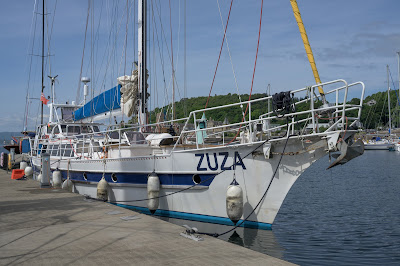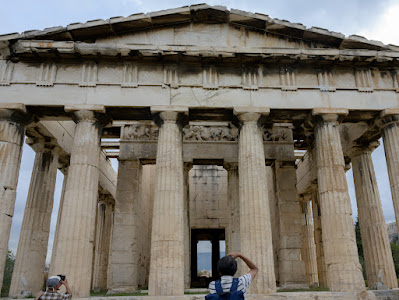29th April - Tiwanaku, a Pre Incan Archaeological Site
To get there the mini van had to drive through El Alto a large settlement which is now part of the La Paz municipality. It has grown up on the hills around the airport, overlooking La Paz. El Alto is occupied by Aymara people who have come in from the countryside in order to find work and has the largest population of native Americans anywhere in the world. In La Paz the best housing is in the valley around the city, poorer people build higher up where the ground is less stable. As this is Bolivia the area is subject to strikes and road blocks as people protest about their conditions.
I will start with a few pictures taken driving through El Alto.
As we drove in to the countryside the land became very flat, dusty and monotonous, although we could still see the mountains in the background.
In truth, once we had got to Tiwanaku we found that that also was rather dusty and monotonous. Not helped by one of the most boring and driest guides we have ever had. However it is obviously an important cultural place.
Tiwanaku is listed as a World heritage Site, I think to save it from certain destruction. What is left has been rifled through by so many amateur archaeologists and plunderers that there is not a lot left to see. But perhaps we had been spoilt by Machu Picchu.
We started the tour in the museum which had one room devoted to a huge monolithic figure (which we were not allowed to photograph). This had spent some time sitting in front of the football stadium in La Paz until it was vandalised. I suspect that it was money gleaned from the World Heritage listing that got it moved.
We then moved on to the ceramics (yawn!), where the guide attempted to tell us a little about the history of Tiwanaku.
Here is their timeline! My description of events in the history of Tiwanaku has been gleaned from Wiki and World Heritage, as I cannot remember one thing the guide said!
Tiwanaku was thought to be founded around 1200BC, growing frost resistant crops on the shores of Lake Titicaca, which was a lot larger then. It lies at an altitude of 3,850m.
During the first century AD it developed in to a small town. The inhabitants canalised the lake to irrigate the land and built artificially raised mounds between the canals to grow their crops on. The canals provided some frost insulation and so greatly increased the yields obtained from the land.
Between 500 and 800 AD the city grew and its inhabitants travelled to other places and absorbed the people there in to their culture. By around 550AD Tiwanaku was the capital of an empire stretching through most of Bolivia, southern Peru, northern Chile and parts of Argentina. The city was improved with civic buildings and in the 8th century AD had a population estimated to be between 70,00 and 125,000. Most of the ancient city was built of adobe and so has disappeared. The monumental buildings were made of stone from two quarries, one about 10 km away and the other near Copacabana, and more of these have survived.
The people worshipped many gods, the chief of which was Viracocha, the creator and destroyer. Like the Inca they also mummified their important dead and believed in reincarnation.
Around the 11th century there was thought to be a major drought that affected the level of Titicaca. With the loss of the water, by the first half of the 12th century the civilisation had died. Patchacutec and the Inca came in in 1445 and took over the remains of the city and the people. Quechua became the official language and the worship of the sun was instituted as the major religion.
After seeing a large number of pots in the museum we went on to see the major stuff outside.
We started with the Temple of Akapana, which was a pyramidal shaped building, originally about 18m high, made of 7 superimposed platforms, the first one of which is now the only one existing. It would have originally been covered with brilliant blue stone, but has now been destroyed by looters.
 |
| Pyramide de Akapana |
Some of the stones had been secured together using braces made from copper or bronze
 |
| The Sun Gate |
Also on the site were two large monolithic figures.
Curiously all the figures had right hands shown in non-anatomical poses. In this one the left hand grasps the keru which was a badge of royalty and the right holds a piece of wood for sniffing halucinogens. Maybe why it is round the wrong way!
The second figure was rather better carved and positioned in front of another gate is such a way that the sun would rise directly behind it on the winter solstice. There was a photograph in the museum of just this event. We walked over to another platform behind the Kalasasaya to see this
 |
| Second monolithic statue |
 |
The platform ran around the edge of a sunken court that had relief heads on the stones lining it. These may have represented the heads of vanquished warriors, they don't look happy. At one time the actual heads would have been displayed here!
 |
| Looking across the sunken temple |
After looking around these parts of the complex the minivan took us off to a lunch area. We had brought sandwiches and sat on some dry grass to eat them. I found a donkey to feed. He seemed grateful.
Lunch over we went off to explore another set of ruins, the Puma Punku, or the Door of the Puma. This is another earth mound faced with stone blocks.
Some of the stone blocks were enormous and some had delicate carvings on them.
We then left the arid temples of Tiwanaku and headed back to La Paz, going back through El Alto, passing a statue of Che Guavara and a place where we stopped to take pictures of La Paz.




























Comments
Post a Comment